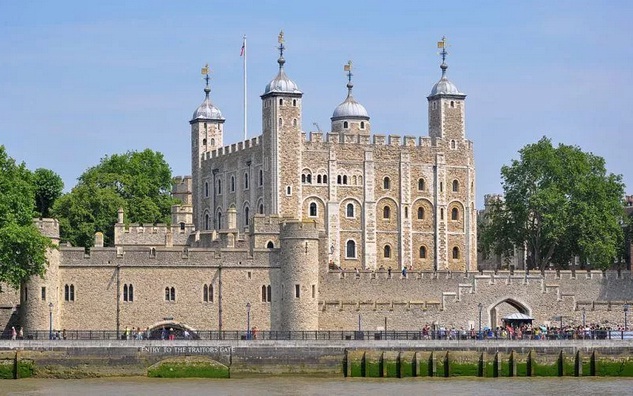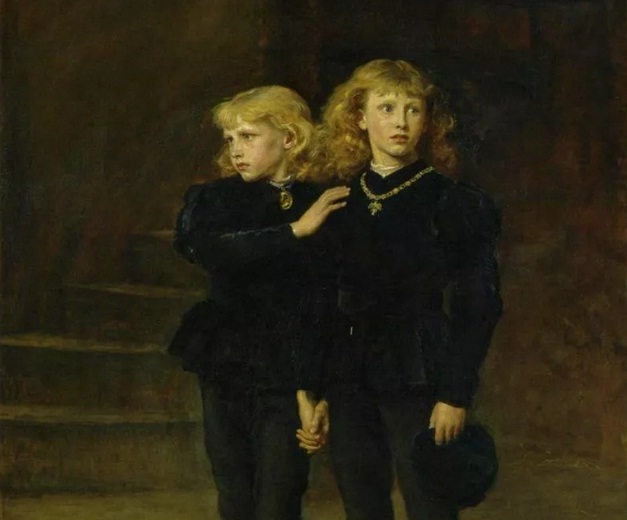No other royal residence in England has been put to such dastardly use or gained such a chilling reputation as the Tower of London.
During the reign of King Henry VIII the Tower was transformed from a heavily fortified palace into a terrifying prison and execution ground.
The notorious Tudor king put five people to death at the Tower in the space of just seven years. Two of whom were his wives.
Let’s take a closer look at this feared place, from its medieval start to the present day…
 Construction Of The Tower Of London
Construction Of The Tower Of London
The central enclosures of the Tower of London were built during the reign of Richard the Lionheart (1189-1199) who was absent from the country at the time, preferring to wage religious war overseas.
Subsequent medieval kings poured money into strengthening the fortifications at the Tower while adding luxurious state rooms.
In medieval times kingship was a treacherous game and a number of kings – such as Henry III, Edward I and Henry VII – felt a little more secure on their thrones when surrounded by extra defensive walls and towers.
Henry III made the most extensive changes to the Tower when he doubled its size at an astronomic cost of £5,000.
He built a new defensive wall along the east, north and west sides of the Tower grounds with nine defensive towers, and added a moat to make triply sure he and his Queen could sleep soundly at night.
Exotic Animals
Henry III is also remembered for introducing the famous Tower of London Royal Menagerie.
Often given as diplomatic gifts, an incredible array of exotic animals began living in the Tower in the 13th century.
The King’s polar bear, which was said to have swam for fish in the Thames, was likely given to Henry III as a friendly gesture by Haakon IV of Norway.
Soon an elephant house was built and there is evidence that lions were housed in the Barbican from around this time.
Later kings continued the tradition of welcoming dangerous wild animals into the Tower.
In the mid 15th century Frederick III, Holy Roman Emperor, donated three leopards to the Royal Menagerie and in 1811 King George III received a large grizzly bear from the Hudson Bay Company.
From around 1700 the menagerie was open to the public and the last animals were relocated to Regent’s Park in 1835.
But for over 600 years more than 60 species of exotic and bewildered animals paced the stone floors of the Tower enclosure.
Princes In The Tower
One of the most disturbing events to take place in the Tower occurred in the year 1483.
During one of the many crises of succession to rock the medieval monarchy, the Duke of Gloucester sent the newly-crowned, twelve year-old Edward V and his younger brother, ten year-old Prince Richard to the Tower for safety.
But the two young boys disappeared and their supposedly caring uncle, the Duke, instantly became King Richard III.
It was long rumoured that Richard III had the boys killed and in 1674 two small skeletons were discovered in the Tower grounds.
King Charles II had the skeletons properly buried and in 1933 modern scientists were able to confirm that the bones belonged to two boys, aged 12 and 10.

Henry VIII
It was during the reign of King Henry VIII that the Tower became a symbol of the cruelty of a century of bloody Tudor rule.
Initially Henry VIII focused on improving his royal lodgings at the Tower, further refining the Great Hall, Tudor Long Gallery, library and the garden his father had built in the Lanthorn Tower.
Henry liked to spend his time at the Tower between Lanthorn Tower and the half-timbered Kings House, near the White Tower that still stands
today.
Yet, while Henry feasted and danced his advisors plotted and schemed to make the King?s dream of independence from the Catholic church a reality.
Henry is best known for being married no less than six times, but in order to get the ball rolling on his serial matrimony he had to have his first marriage annulled.
The Pope’s refusal to grant Henry an annulment led to the English Reformation, a seismic change in English life that saw the creation of the Church of England.
As Supreme Head of the Church, Henry was able to make radical changes to the English Constitution and assert his own kingly will as the highest authority in the land.
It was Henry’s determination, helped along by his sycophantic advisors, that allowed him to fill the Tower prison with heretics and traitors.without evidence of wrong-doing.
Henry had his second wife, Anne Boleyn, sent to the Tower accused of incest, adultery and plotting to kill the king.
On the 19th of May 1536, four days after her arrest, Anne was beheaded by a French swordsman on a specially erected scaffolding on the north side of the White Tower.

Catherine Howard, Henrys fifth wife, met the same fate as Anne but unlike her predecessor she entered the Tower through the iconic Traitor’s Gate.
Lady Rochford was executed soon after Catherine, accused of having helped her carry out the adultery that was interpreted as treason against the king.
More Bloody Tudor History
Following Henry’s death, the tragic Lady Jane Grey was beheaded in February 1533/34 on the Tower Green under charges of high treason and was succeeded by Mary I.
Inspired by their father Henry, both Mary and her half-sister and successor Elizabeth I had a number of others executed at the Tower of London.
Robert Devereux, Earl of Essex and a former favourite of Elizabeth, was the last person to be executed on Tower Green in 1601.
Life After The Tudors
The Tower of London was not used as a royal residence after the reign of King Henry VIII, nor was it regularly used as an execution ground after the reign of Elizabeth I.
Yet the Tower continued in its function as a prison right up to the 20th century.
During the Second World War, it was used to hold prisoners of war such as Rudolf Hess, Adolf Hitler’s deputy, who was held there for four days in1941 and was the last state prisoner confined at the castle.
Ever since the Tower of London opened its doors to tourists in the Victorian age, visitors have been thrilled by its dark reputation as a place of torture, murder and hauntings.
While this sinister image is certainly part of the Towers story, it is not the whole picture.
The Tower Óf London Today
Today, the Tower is known for its exhibition of the Crown Jewels, a collection of the most sacred ceremonial objects in Great Britain, for being the ceremonial regimental headquarters of the Royal Regiment of Fusiliers and for being home to the iconic Yeoman Wardens, or Beefeaters.
The Yeoman Wardens are responsible for the safety of the Crown Jewels, the security of prisoners and other ceremonial duties.
One such duty is caring for the Tower’s six ravens. A superstition that has endured since the 17th century, it is believed that “if the Tower of London ravens are lost or fly away, the Crown will fall and Britain with it”.
The Tower of London, is not only one of the most historic buildings in a country teeming with them, it’s also a great, and important, place even now.
Any trip to London is incomplete with a trip to the Tower. Apart from anything else, you can just check that the ravens are still there….







Sé el primero en comentar